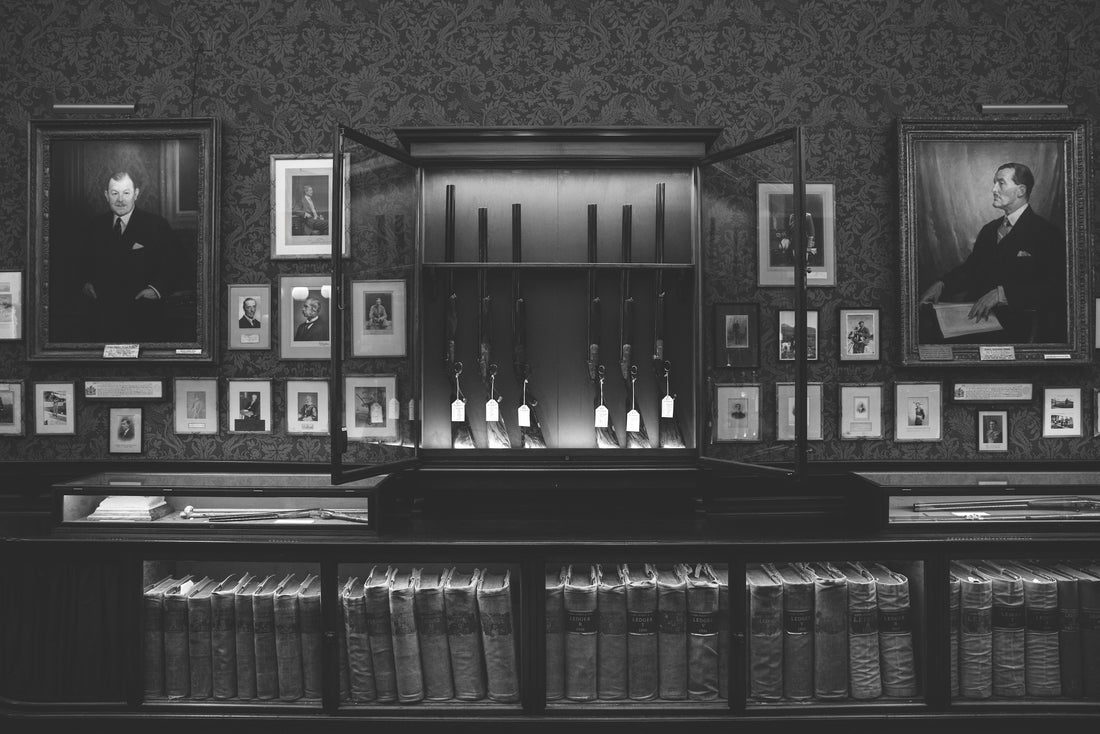The Long Room is a unique survivor of the Golden Age of gunmaking and game shooting. A fabled space within London’s Audley House, it has hosted the greatest shots of the last two centuries, many of whose portraits keep a watchful eye over those who step inside today. It has also played an important role in wider British history, with plans for the D-Day landings hatched in secret around its table during the Second World War.
Built as part of the original design of the Queen Anne-style Audley House – which became Purdey’s home on 1 January 1883 – the Long Room was intended as both the company’s showroom and an office for James Purdey the Younger and his sons. It has remained a working space since its inception, displaying guns as well as a unique collection of images and memorabilia, serving successive generations for business and entertainment alike.
It is also a rare survivor, believed to be the oldest gunroom still in operation, and certainly the last in Mayfair. In the 1920s, Purdey described the room as holding ‘the history of shooting for a hundred years’, and it continues to do so today, as we celebrate its 140th anniversary at the heart of the London gun trade.

The story of the Long Room is intertwined with interesting people. Its name reputedly comes from one of James the Younger’s personal friends, the Victorian cricketer Dr WG Grace. Both men were immortalised by the same portrait artist, and these hang in their respective Long Rooms (there’s also a Long Room at Lord’s Cricket Ground, you see).
Royalty plays a big part in Purdey history. Looking to the British monarchy, both Edward VII and George V contributed signed photographs to the Long Room’s collection, and their descendants were hosted at Long Room dinners as recently as the 1990s. It has also seen visits from European and Asian royals, from King Alfonso XIII of Spain to the Maharajahs of India.
This patronage led members of the nobility and gentry to Audley House, and the Long Room played host to many greats of the 19th century, including Earl de Grey and Lord Walsingham – fierce rivals in the field, but unified in their preference for Purdey hammer guns. It’s a tradition that continued into the interwar period, when the famed African hunter, JA Hunter procured his own pair of Purdey guns via the Long Room.

From America, many of the most famous families likely passed by the Long Room when purchasing Purdey guns to complete their kit when shooting in England. Members of the Vanderbilts, Astors and Carnegies all appear in the accounts at the turn of the century, and were joined later by the newspaperman, Joseph Pulitzer II, and the film star, Douglas Fairbanks Jr. When Purdey purchased James Woodward & Sons in 1949, other notable clients joined our books, including Sir Winston Churchill, who used Purdey as his gunmaker up until his death in 1965.
The room has also played its part in wider world events. The Gunmakers’ Association (now the Gun Trade Association) and the Worshipful Company of Gunmakers both used the room for their meetings during the 1930s and 1940s, and several pieces of UK legislation were drafted here. Perhaps most famously, meetings of General Eisenhower’s Invasion Committee were held in the Long Room circa 1943, allowing both he and his right-hand man, General Walter Bedell Smith, to gather discreetly with John Cobbold, both the British military liaison and one of Purdey’s directors. Bedell Smith, better known as ‘Beetle’, also used to bring the Purdey brothers gifts when he visited, including two US Army M1 carbines!
Today, the Long Room continues to serve as a record of all Purdey clients, past and present, as well as welcoming new visitors daily, eager to follow in the footsteps of so many renowned individuals, and perhaps become a part of the same tradition themselves.
Take a virtual tour of Audley House, here, or get in touch to visit the Long Room in person.
